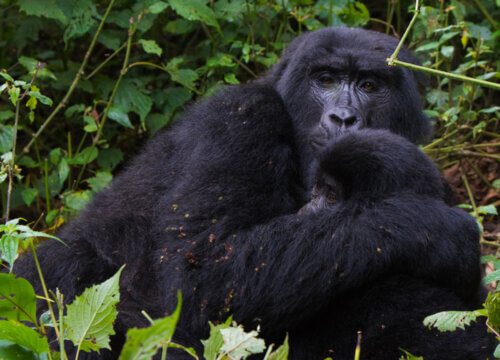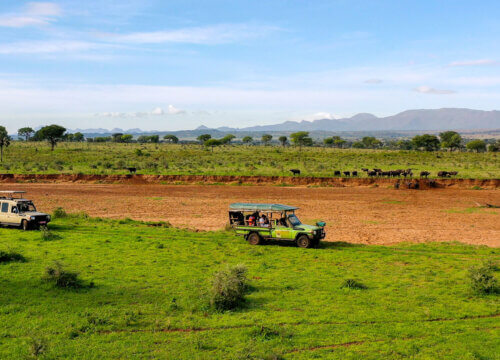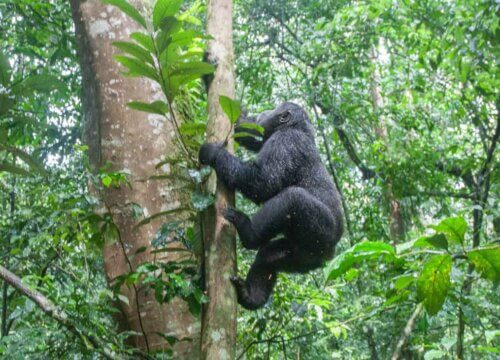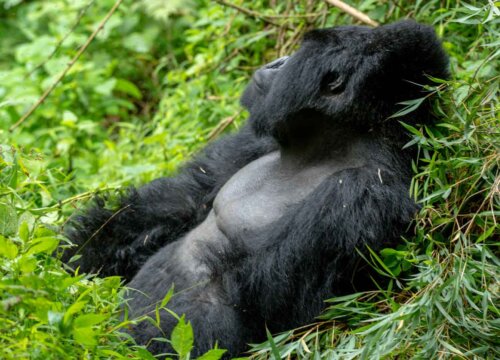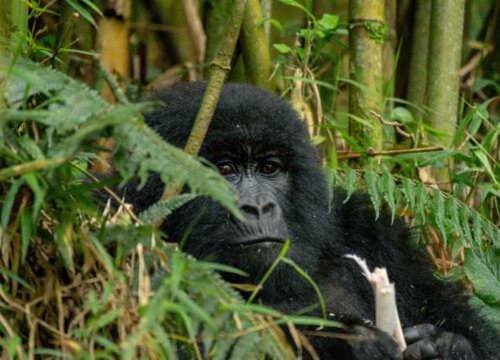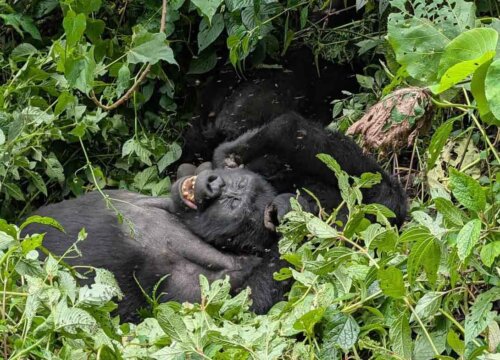Is it possible to trek chimpanzees without a ranger in Kibale Forest National Park?
Is it possible to trek chimpanzees without a ranger in Kibale Forest National Park?
If you are wondering whether you can do chimpanzee trekking without a ranger in Kibale Forest National Park, the answer is no because of safety and conservation reasons set by Uganda Wildlife Authority. Chimpanzee trekking in Kibale is conducted under the guidance of experienced rangers. These rangers are well trained to make sure you are safe while crossing the dense forest and meeting wild chimpanzees. Chimpanzees being highly intelligent and sometimes unpredictable require careful observation and a respectful distance. Rangers are well-trained to interpret their behavior and guide visitors accordingly. Rangers also help in saving chimpanzees during times when they get out of control.
Additionally, the presence of rangers helps to protect the chimpanzees themselves. By following strict guidelines, they ensure that human interaction does not disrupt chimpanzees’ natural behavior or expose them to health risks. In case tourists go on a self- guided chimpanzee trek, they may panic and hurt chimpanzees as a way of self-defense especially if they are not trained on how to deal with them. Another role of rangers is to use their familiarity with Kibale Forest National Park and guide you through this tropical rainforest with thick trees that can confuse visitors.
Trekking with a ranger improves the chimpanzee trekking experience because their knowledge and expertise provide interesting insights into the lives of these chimpanzees which makes your trip even more satisfying. Kibale Forest National Park connects to Queen Eizabeth National Park from the southern part which allows wild animals to cross into this park. During chimpanzee trekking, you will meet some of these animals for example warthogs, elephants, leopards and lions that are very dangerous when you do not have a defense weapon.
About Kibale Forest National Park
Kibale Forest National Park is a tropical rainforest located in western Uganda famous for its rich biodiversity and natural beauty. The park spans approximately 795 square kilometers. Kibale Forest National Park is home to more than 12 species of primates including chimpanzees, red colobus monkeys, bush babies, pottos, olive baboons and L’Hoest monkeys. Visitors can enjoy guided chimpanzee tracking experiences to see these chimpanzees in their natural home.
Besides primates, Kibale has more than 325 bird species like shoebill stork, yellow spotted nicator, crowned eagles, blue headed sunbird and others. colorful butterflies and mammals such as forest elephants, duikers and bush pigs are also found in this park. The beautiful greenery, towering trees and calm atmosphere make it perfect for tourists who want to relax.
Expectations during chimpanzee trekking in Kibale Forest National Park
Kibale Forest National Park is home to one of the highest populations of chimpanzees in the world. First of all, prepare for an early start. Chimpanzee trekking begins in the morning at Kanyanchu visitors center led by experienced guides who will brief you on safety and the behavior of chimpanzees. The hike can change in length depending on where the chimpanzees are located that day, so comfortable walking shoes and some level of fitness are needed.
As you walk through Kibale Forest National Park, you will be surrounded by more than 352 giant trees which rise to about 55 meters, birds and monkeys swinging from the trees. Once you locate chimpanzees, you will have a chance of seeing them in their natural home playing, feeding and interacting for one hour. You can choose a morning or afternoon chimpanzee trekking experience. For more details on what to expect during your chimpanzee trekking experience, contact Giant Holiday Safaris.
When to visit Kibale Forest National Park for chimpanzee trekking
Knowing the best time to visit Kibale Forest National Park can make your trip more enjoyable. The park is open throughout the year but the dry seasons from December to February and June to September are the best times for chimpanzee trekking. During these months, the trails are less muddy making it easier to cross Kibale Forest National Park. The weather is also more predictable which increases your chances of seeing chimpanzees because they are more active and easier to track during the dry season.
On the other hand, The wet seasons from March to May and October to November are good if you do not mind rain and muddy roads. During this time, the grass is greener and and there are fewer tourists which gives tourists a more private experience. In addition, permits are always easier to secure during this time. Note that chimpanzee trekking permits are few during the dry or peak season because tourists are usually very many so you need to book your permit in advance with Giant Holiday Safaris to avoid disappointments.
How safe is chimpanzee trekking in Kibale Forest National Park?
Kibale Forest National Park in Uganda is one of the best and safest places for chimpanzee trekking. The park is well managed and the guides are highly trained to make sure that visitors have a safe and enjoyable experience. Trekking is carried out in small groups and visitors are escorted by experienced rangers who are knowledgeable about chimpanzee behavior and the forest environment. One ranger holds a machete and another carries a riffle for emergency.
Chimpanzees in Kibale are used to seeing people and are less likely to feel threatened when met by tourists. However, safety protocols are in place to protect both visitors and the animals. For example, trekkers are advised to maintain a safe distance from the chimpanzees, avoid sudden movements and follow all instructions given by the guides.
Why choose chimpanzee trekking in Kibale Forest National Park?
Chimpanzee trekking in Kibale National Park has 15 trekking communities with more than 1500 chimpanzees in the park which increases chances of permit availability. The experience gives tourists a unique opportunity to see chimpanzees in their natural home. You will be guided by expert trackers as you go through the impenetrable forest listening to chimpanzee calls and watching them swing through the trees. Kibale Forest National Park is not just about chimpanzees, it is a biodiversity combined with other primates, colorful birds and beautiful flora. The trek itself is an adventure in the calm beauty of the rainforest.
Accommodation options to book for chimpanzee trekking in Kibale Forest National Park
Kibale Forest National Park has accommodation that ranges from luxury, mid-range to budget. Booking accommodation near the park is important so that you catch up with chimpanzee trekking briefing in the morning. Accommodation options include chimps nest, Ndali lodge, Kyaninga lodge, primate’s lodge and Kibale safari lodge. For more information about a lodge of your interests, please reach out to Giant Holiday Safaris.
How long does chimpanzee trekking take in Kibale Forest National Park?
The duration of chimpanzee trekking in Kibale Forest National Park usually changes and the activity needs patience but takes between 2 to 3 hours. The actual time it takes to find chimpanzees depends on their movements because they are very active and can quickly move through the forest looking for food or visiting the family of a dead community member. Once you find them, you will have about an hour watching them interacting, feeding and playing. The journey can range from being easy to being moderately challenging depending on the ground and the location of chimpanzees that day.
Who is allowed to do chimpanzee trekking in Kibale Forest National Park?
Chimpanzee trekking in Kibale Forest National Park is for participants who are at least 12 years old. This age limit is in place to make sure that both visitors and the chimpanzees are safe because younger children may disturb the animals or struggle with the physical demands of trekking. In addition, many things in the jungle may push children below 12 years to shout for example chimpanzee looks or their abrupt touches. Additionally, trekkers should be in good physical condition. The activity involves hiking through the dense forest usually on rough ground and may require walking for several hours. Chimpanzee trekking is not overly tiring but some level of fitness will make the experience more enjoyable. Children can participate in activities like pond dipping, photography and cyanotype under the guidance of trained rangers in Kibale Forest National Park.
Is chimpanzee trekking difficult in Kibale Forest National Park?
Chimpanzee trekking in Kibale Forest National Park is a little tiring. The trek usually lasts between 2 to 3 hours depending on how quickly the chimpanzees are located. The landscape is not very steep and the undergrowth is scattered with shrubs and herbs. During wet periods, the ground gets damp but not slippery. More light is let in through the semi closed tree shelters. The ranger guide with a machete uses it to trim trees and make a path for tourists to access chimpanzees. While it is not a risky adventure, a moderate level of physical fitness is required to fully enjoy the journey.
Guidelines regarding chimpanzee trekking in Kibale Forest National Park
- Always follow the guides’ lead and listen carefully to their instructions. They are experts in crossing the forest and understanding chimpanzee behavior.
- Keep your voice low, avoid pointing or waving your arms and move slowly to avoid disturbing chimpanzees.
- Photography is allowed but taking pictures with flash light is strictly prohibited because it can scare or irritate the chimpanzees.
- Carry all trash out with you and avoid picking plants or disturbing the natural environment of chimpanzees.
- If you are feeling unwell, it is best to postpone your trek. This helps in protecting these chimpanzees from infections.
- Chimpanzee trekking age limit is 12 years and above.
- If you want to eat or drink before chimpanzees, do it when you are at least 200 meters away from them. Wild animals must search for their own food.
- If you want to defecate, ask a ranger guide to dig for you a hole of at least 30 cm deep and cover it beyond recognition after.
Explorer More Safaris
- 14-Days Uganda Safari Gorilla Chimpanzees and Wildlife
- 12 Days Gorillas and Chimpanzees Wildlife Safari
- 10 days best of uganda primates & wildlife safari
- 6 Days Gorillas and Chimpanzee Trekking Safari
- 3 Day Bwindi Gorilla Trekking Safari
- 4 Day Uganda Gorilla Trekking and Wildlife Safari
- 4 Days Gorilla Trekking and Adventure Safari
- 5 Days Uganda Gorillas and Chimpanzee Tracking Safari
- 4-Day Rwanda Gorilla Trekking and Golden Monkey Tracking Safari
- 5 Day Gorilla Habituation and Chimp Trekking
- 4-Day Uganda & Rwanda Gorilla Trekking Tour
- 3 Days Bwindi Gorilla Trekking Ugnada from Rwanda
- 10 Days Uganda Primates and Game Safari

